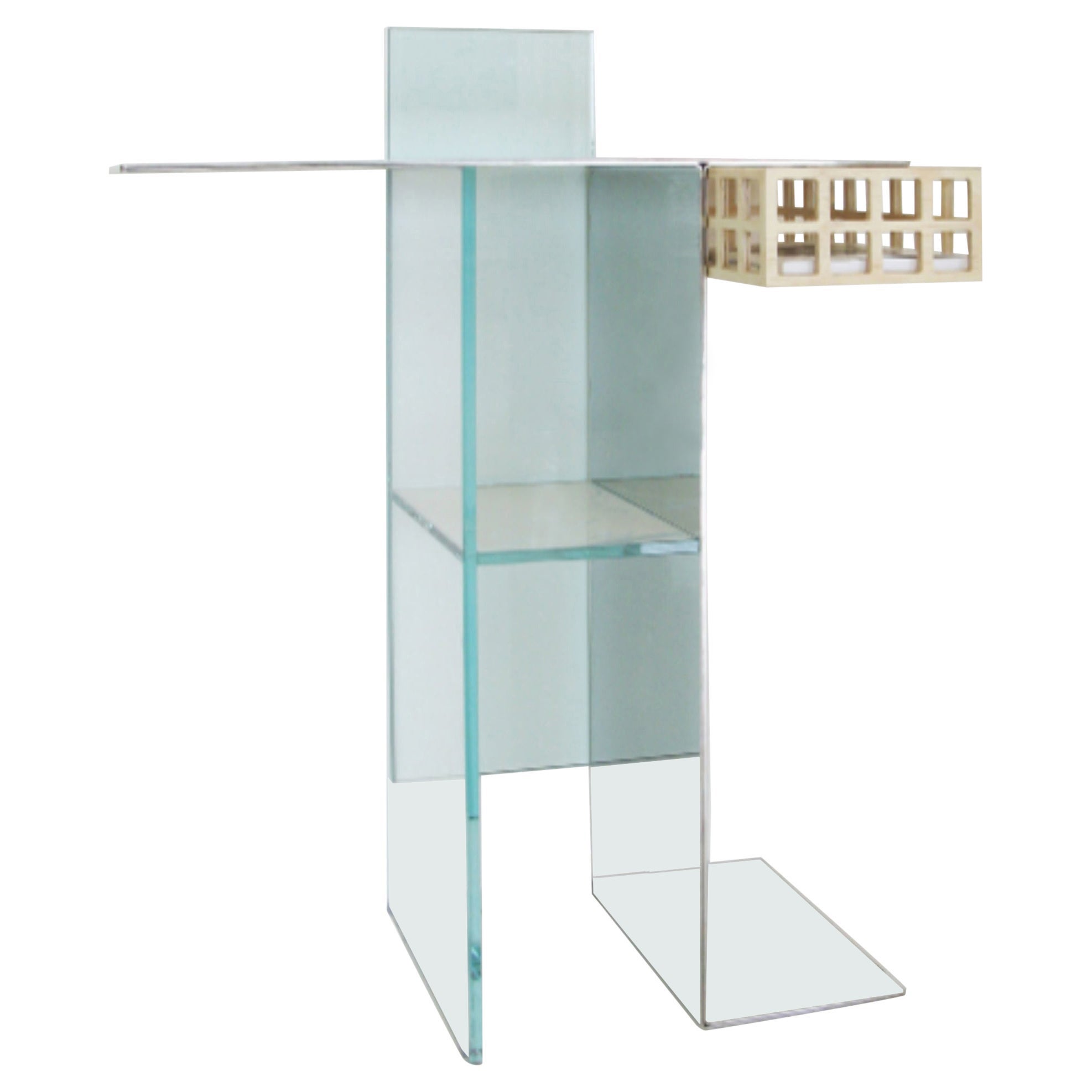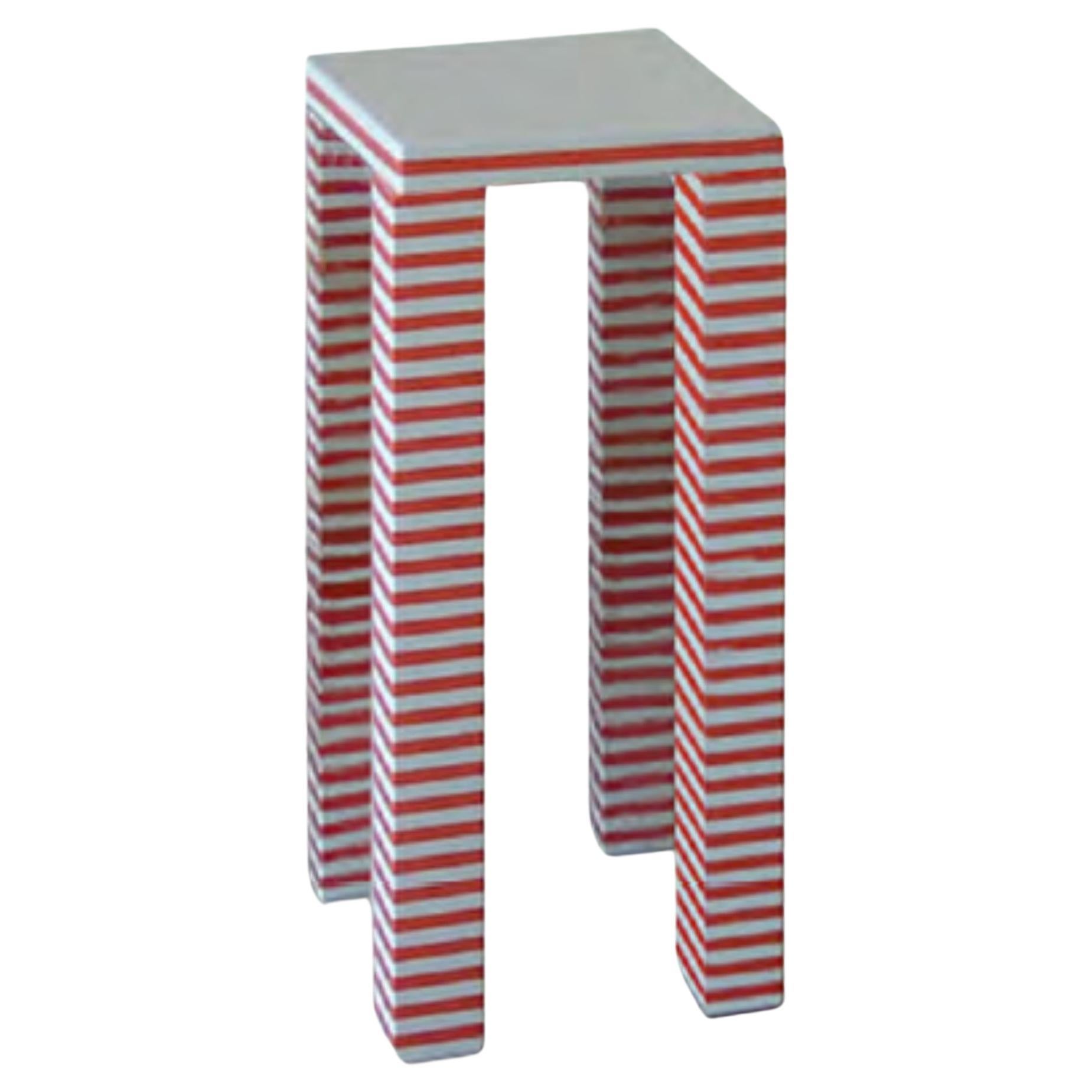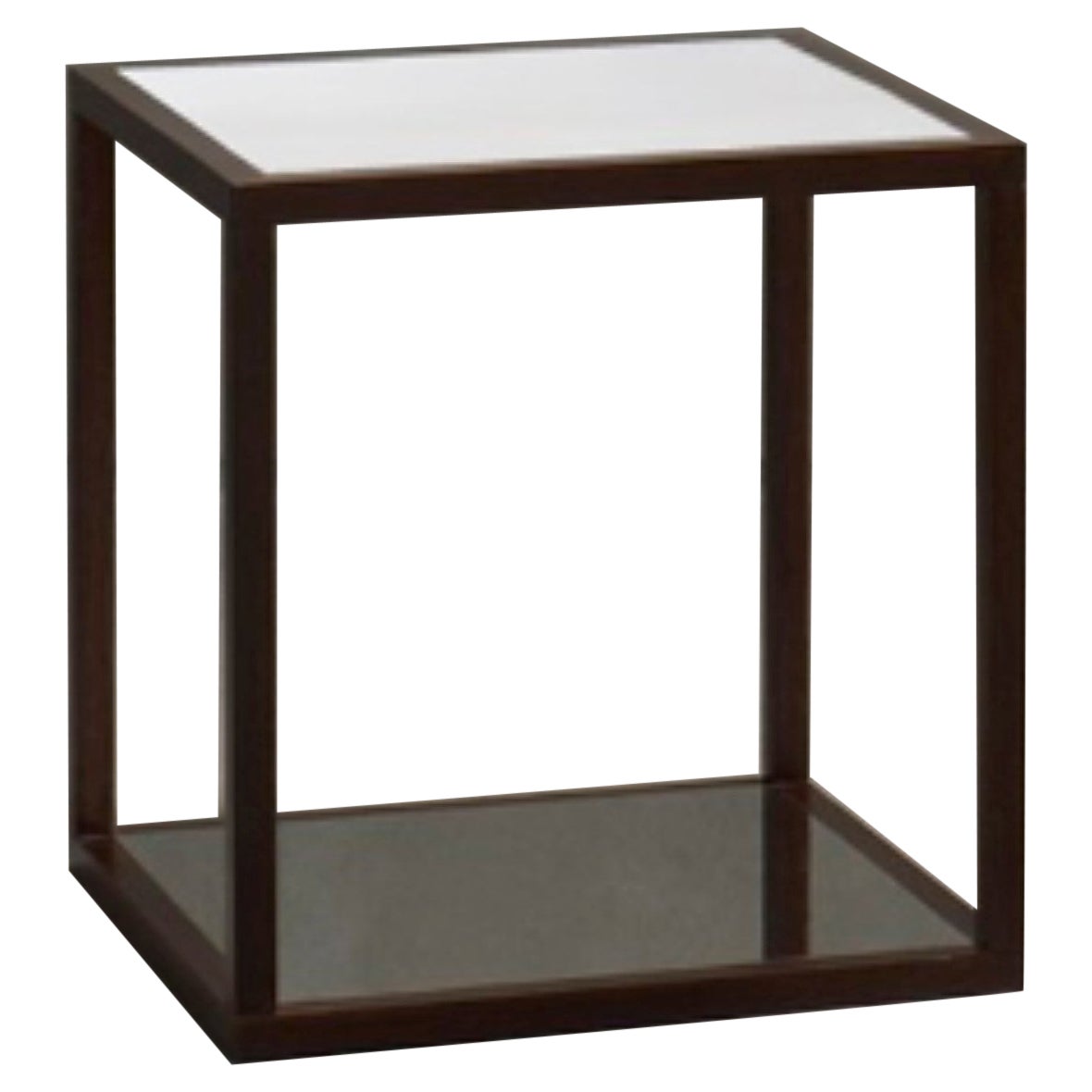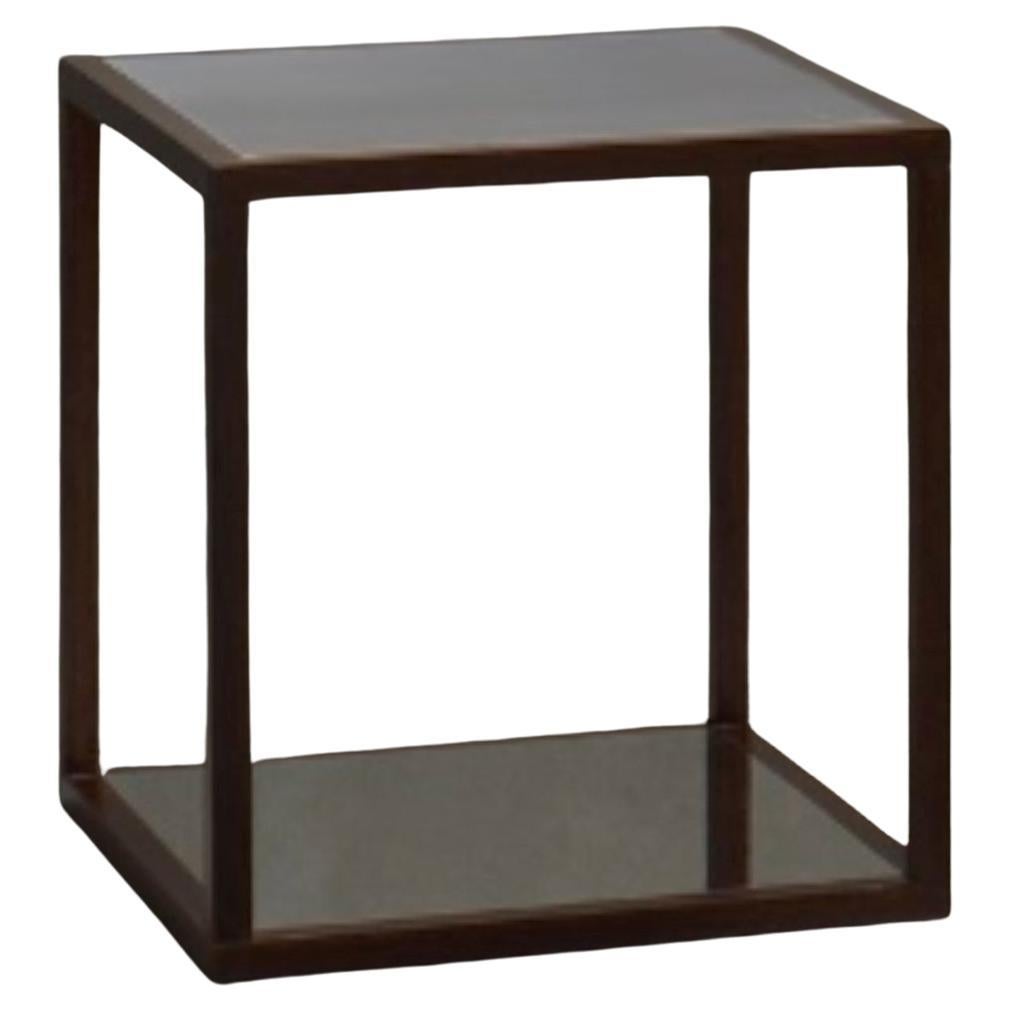Want more images or videos?
Request additional images or videos from the seller
1 of 6
Cf C299 by Caturegli Formica
About the Item
CF C299 by Caturegli Formica
Dimensions: W 87 x D 25 H 130 cm
Materials: Aluminum, glass, wood
Calligrams 2015-16
What we design and then realize often has a hidden meaning. As ideograms of a mysterious and at the same time familiar language. As sounds of animals well known to us though, we cannot understand their meaning at all. The calligrapher Muso Sozeki Kokushi suggested that perhaps we are not able to interpret the meaning of what happens to us and even to judge whether an event proves to be positive or negative for us.
Our theories are like buildings on the sand: both the beginning and the end of our existence are completely obscure to us. Theorems that develop into long demonstrations, lacking both the premise and the conclusion. Like being in a labyrinth of logic with no way to go back, no map to exit, but not even the awareness of the entrance.
We can only walk in the present, using signs, fragments, sometimes ruins, skeletons, coating panels, parts of mechanisms... as in a calligram that can outline a poem unknown, but of the existence of which we are sure..
Biographical notes
Beppe Caturegli (1957) and Giovannella Formica (1957-2019) shared a background in the cultural atmosphere of the Radical Architecture movement in Florence. After taking architecture degrees in 1982, they moved to Milan to begin a long, intense working relationship with Ettore Sottsass, the Memphis group and the magazine Terrazzo.
In 1987 they opened the Caturegli Formica Architetti Associati studio and for ten years they worked as consultants for Computer Associates, a US-based software firm, for which they designed facilities in Milan and Rome. Alongside work on architecture and interiors, they have designed products for many different Italian and international companies, including Sanyo, WMF and Fontana Arte.
Their curiosity and passion for architecture around the world has led to frequent trips to the United States and Japan, and then regular travels in India and several African countries, where they have conducted research in collaboration with local architects, artists and artisans. The aim is to enrich the meaning of products, projects and works of architecture, using mixed systems: industrial/crafts, global/local, mass-produced/one-off.
In the period 1987-1991 they created Terre, a ceramics series produced in the workshop Céramiques Almadies, and collaborated with the design group 100% Dakar, honoured by the President-poet Léopold Senghor for their work on racial integration.
From 1989 to 1993 they worked on the restoration and extension of a vast estate in Madras (Chennai), and made a series of symbolic stone objects in collaboration with the sculptors of Mahabalipuram.
Their work is very heterogeneous, ranging from residential and commercial architecture to restoration, interiors to furniture, lamps and flatware, paintings and ceramics to video.
Since the early 1980s they have designed carpets, seen both as useful objects and as maps of knowledge. Most of the carpets are part of site specific works for private clients. This is a way of working on the applied arts that goes almost against the current, in a period in which industrial design moves toward global standardization and uniformity.
In 1989 they participated, together with the Memphis group, in the exhibition Carpets at the Design Gallery, and created a collection of carpets and tapestries for Elio Palmisano in Turkey and Italy. Later, they have also worked in Iran, China, Singapore, Hong Kong, Kashmir and Tibet, collaborating with craftsmen and selecting small companies that use purification systems for water used in colouring, and apply procedures for the safety and well-being of workers.
Since 2004, Nilufar Gallery has shown the Caturegli Formica carpets collections .
In 2007, for the exhibition Onehundred, they presented Super-market, a collection of cabinets called Photo-boxes and characterized by images reproduced on the doors that show the geography of global consumption and document real places and objects of the planet.
In 2010 they presented a series of twenty photo-montages and eight collections of rugs for their exhibition Nodi/Hubs, a kind of reflection on certain macro-knots of occidental thinking: the environment and consumption of the territory, genetics and GMOs, catastrophes, chaos theory, archival storage and the mind, the chemical essence of life.
One aspect of their research, honoured with international prizes and publications, is the structural use of colour and light in architecture. More recently, they have put great commitment and research into an energetic use of light, in the context of bio-architecture projects with objectives of heightened sustainability.
In 2004-2014 they carried on the project of restoration and revitalization of a vast historic property in Tuscany, where they have applied advanced solutions for energy supply and savings, through the use of a range of integrated alternative energy sources. The Tenuta dello Scompiglio estate includes a theatre, rehearsal rooms for musicians, an art gallery, a restaurant, residences for artists and many hectares for biodynamic agriculture.
In 2014-2017 they designed several spaces devoted to host art collections and produced seven new rugs collections, embroideries, furnitures, vessels, photomontages and concept books.
Their works have been showed at the Deichtorhallen Hamburg, Centre Pompidou Paris, Mino Ceramic Art Museum Japan, Metropolitan Museum of Art NYC, Triennale di Milano...
- Dimensions:Height: 51.19 in (130 cm)Width: 34.26 in (87 cm)Depth: 9.85 in (25 cm)
- Style:Post-Modern (Of the Period)
- Materials and Techniques:Aluminum,Glass,Wood,Other
- Place of Origin:Italy
- Period:2010-
- Date of Manufacture:2022
- Production Type:New & Custom(Current Production)
- Estimated Production Time:7-8 weeks
- Condition:
- Seller Location:Geneve, CH
- Reference Number:1stDibs: LU1219234015292
Galerie Philia
Galerie Philia is an international contemporary sculptural design and art gallery representing emerging and established designers and artists. The gallery is the brainchild of two brothers who share a lifetime passion for art, literature and philosophy. Their distinct academic background sets them apart from their peers, as it sees them following a rhizomatic and transcultural approach in the way they select works. This involves combining elements from multiple cultures in what becomes a network of harmoniously interconnected roots, ultimately revealing the beauty of each unique creation. The gallery’s non-hierarchical curation sits apart from the ephemerality of trends and focuses instead on the true aesthetic quality of the piece – alluring and timeless. Unlike others, Galerie Philia does not focus on a single style – whether minimalist, organic or raw – but rather embraces heterogeneity. The Galerie Philia takes pride in discovering new talents, providing them with multiple international platforms to showcase their latest creations. As well as propelling the newest generation of 21st century collectible design, Galerie Philia also works with internationally known design artists. Galerie Philia has a strong international presence, with galleries in Geneva, New York and Singapore. In addition to their permanent spaces, the gallery organizes temporary group exhibitions and artists residencies in first-class locations around the world.
Made to order creations can be done: please contact us for any request.

About the Seller
5.0
Diamond Seller
These expertly vetted sellers are 1stDibs' most experienced sellers and are rated highest by our customers.
Established in 2015
1stDibs seller since 2015
4,132 sales on 1stDibs
Typical response time: <1 hour
- ShippingRetrieving quote...Ships From: Milano, Italy
- Return PolicyA return for this item may be initiated within 7 days of delivery.
More From This SellerView All
- Cf C296 by Caturegli FormicaLocated in Geneve, CHCF C296 by Caturegli Formica Dimensions: W 140 x D 30 H 140 cm Materials: Aluminum, polycarbonate, oak. Calligrams 2015-16 What we design and then realize often has a hidden ...Category
2010s Italian Post-Modern Tables
MaterialsAluminum, Other
- CF C298 by Caturegli FormicaLocated in Geneve, CHCF C298 by Caturegli Formica. Dimensions: W 75 x D 41.5 H 95 cm. Materials: Steel, glass and plywood. Calligrams 2015-16 What we design and then realize often has a hidden me...Category
2010s Italian Post-Modern Tables
MaterialsAluminum, Other
- Cf Ct16 High-Table by Caturegli FormicaLocated in Geneve, CHCF CT16 High-Table by Caturegli Formica Dimensions: W 40 x D 40 H 130 cm Materials: Corain Biographical notes Beppe Caturegli (1957) and Giovannella Formica (1957-2019) sha...Category
2010s Italian Post-Modern Tables
MaterialsCorian
- CF T22 Dinner Table by Caturegli FormicaLocated in Geneve, CHCF T22 dinner table by Caturegli Formica. Dimensions: W 140 x D 140 H 73 cm. Materials: Corain. Biographical notes Beppe Caturegli (1957) and...Category
2010s Italian Post-Modern Tables
MaterialsCorian
- CF LT07.5 Low Table by Caturegli FormicaLocated in Geneve, CHCF LT07.5 low table by Caturegli Formica Dimensions: W 38 x D 38 H 40 cm Materials: Wood, Plastic The top of low tables changes its colour according to the point of view. S-Steel structure available Biographical notes Beppe Caturegli...Category
2010s Italian Post-Modern Tables
MaterialsPlastic, Wood
- CF LT07.5 Low Table by Caturegli FormicaLocated in Geneve, CHCF LT07.5 low table by Caturegli Formica Dimensions: W 38 x D 38 H 40 cm Materials: Wood, Plastic The top of low tables changes its colour according to the point of view. S-Ste...Category
2010s Italian Post-Modern Tables
MaterialsPlastic, Wood
You May Also Like
- Charlotte Perriand Metal, Wood and Formica Table for Cansado, circa 1950By Charlotte Perriand, Steph SimonLocated in Barcelona, BarcelonaTable designed by Charlotte Perriand, circa 1950 from Cité Cansado, Mauritania, Africa. Painted steel, plastic laminate-covered wood. Measures: 74.3 x 80 x 80 cm In good original condition, with minor wear consistent with age and use, preserving a beautiful patina. Charlotte Perriand (1903-1999) she was born in Paris in 1903 and attended the E´cole de l'Union centrale des Arts de´coratifs from 1920-1925. Charlotte Perriand designed furniture made of anodized aluminium and chromium-plated steel, showing it at the 1927 "Salon d'Automne" in Paris. After meeting Le Corbusier, Charlotte Perriand worked with him and Pierre Jeanneret until 1937. The revolutionary tubular steel furnishings and system furniture designed by the three were presented as "E´quipement de l'habitation" (home equipment) at the 1929 "Salon d'Automne," where they were widely acclaimed. In 1930 the Union Des Artistes Modernes (UAM) was founded in Paris, a group that viewed itself as a countermovement challenging such establishment organizations as the "Salon d'Automne" and also advocated Art Deco and Modernism. From 1931 Charlotte Perriand showed her own work solo there. In 1937 Charlotte Perriand and Pierre Jeanneret collaborated on designing a mountain chalet of sheet aluminium, which they showed at the "Exposition Internationale des Arts et Techniques dans la Vie Moderne" and later they came up with plans for prefab houses made of aluminium. In 1940 Charlotte Perriand became a design consultant to the Japanese Board...Category
Vintage 1950s Mauritanian Mid-Century Modern Tables
MaterialsSteel
- Disco Hanging Table Brass and Natural Cork by by decarvalho atelierBy Decarvalho AtelierLocated in São Paulo, BRrecord hanging table The disco suspended table proposes a new vision for side tables, with the fixation on the ceiling its stability is due to the count...Category
2010s Brazilian Post-Modern Side Tables
MaterialsBrass
- Nisus Accent Table by Alter Ego StudioLocated in Castelo da Maia, PTNisus Accent Table by Alter Ego Studio Dimensions W 66 cm D 66 cm H 41 cm Product features Product options: Upholstery: Available in all Alter Ego Studio leathers and fabrics....Category
2010s Post-Modern Side Tables
MaterialsStone
- Disco Support Table Brass and Natural Cork by decarvalho atelierLocated in São Paulo, BRThe disco side table was developed to be easy, both in transport and in height adjustment, so it adapts to any indoor environment. The height of the top can be adjusted using the pin located next to the stem, its finishes, like the entire Disco collection, are in 3 metals, brass, nickel and onyx, and the tops can be made of natural cork or rubberized black cork. It goes well with side table and disco side table. It brings elegance and charm to the chosen environment. 100% handmade in Brazil. Designed by Designer Bruno de Carvalho - atelier decarvalho...Category
2010s Brazilian Post-Modern Side Tables
MaterialsBrass
- Disco Hanging Table Onix and Rubberized Black Cork by decarvalho atelierBy Decarvalho AtelierLocated in São Paulo, BRrecord hanging table The disco suspended table proposes a new vision for side tables, with the fixation on the ceiling its stability is due to the counte...Category
2010s Brazilian Post-Modern Side Tables
MaterialsBrass
- Disco Support Table Brass and Rubberized Black Cork by decarvalho atelierLocated in São Paulo, BRThe disco side table was developed to be easy, both in transport and in height adjustment, so it adapts to any indoor environment. The height of the top can be adjusted using the pin located next to the stem, its finishes, like the entire Disco collection, are in 3 metals, brass, nickel and onyx, and the tops can be made of natural cork or rubberized black cork. It goes well with side table and disco side table. It brings elegance and charm to the chosen environment. 100% handmade in Brazil. Designed by Designer Bruno de Carvalho - atelier decarvalho...Category
2010s Brazilian Post-Modern Side Tables
MaterialsBrass
Recently Viewed
View AllRead More
Galerie Philia Unveils Limited-Edition Designs at Giampiero Tagliaferri’s New L.A. Studio
For the exhibition “Materia Perpetua,” the gallery asked an international group of makers — including Tagliaferri — to explore the possibilities of a surprisingly versatile material: onyx.
Galerie Philia Doesn’t Just Discover Fresh Design Talent — It Grows It
With an impressive slate of international exhibitions, the Geneva-based gallery raises the profiles of emerging designers.
More Ways To Browse
Small End Table Storage
Architectural Building Parts
Architects Table With Storage
Aluminum Group Table
Italian Formica Table
Japanese Ceramic Table
Theatre Glass
Chinese Wood Glass Doors
Flatware Storage Cabinet
Cf Modern
Fontana Arte Signed
Glass Negatives
Wood Posts Africa
Small African Table
Glass Entrance Table
Japanese Wood Glass Table
Glass Extension Table
Chinese Furniture Musicians






